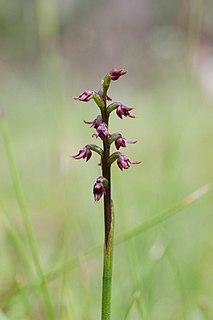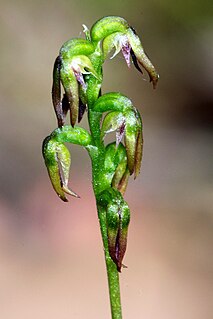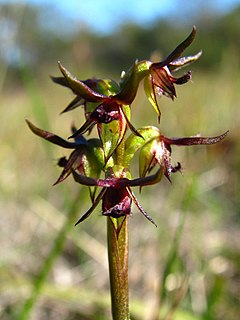
Genoplesium nudum, commonly known as the tiny midge orchid in Australia or the red midge orchid in New Zealand, is a small terrestrial orchid native to south-eastern Australia and New Zealand. It has a single thin leaf fused to the flowering stem and up to forty small, reddish-purple or green and red flowers. Australian and New Zealand authorities use the name Corunastylis nuda but Genoplesium nudum and Prasophyllum transversum are used by the World Checklist of Selected Plant Families.
Genoplesium rufum, commonly known as the rufous midge-orchid, is a species of orchid endemic to New South Wales. It has a single thin, wiry leaf and up to twenty five drooping, pinkish or reddish flowers on a flowering stem which is fused to the lower part of the leaf. It was formerly thought to range from Queensland to South Australia and Tasmania but specimens in other states are now assigned to Genoplesium clivicola.

Genoplesium despectans, commonly known as the sharp midge orchid and known as Corunastylis despectans in Australia, is a small terrestrial orchid endemic to south-eastern Australia. It has a single thin leaf fused to the flowering stem and up to forty five small, dark purple or green and purple flowers.

Genoplesium morrisii, commonly known as the bearded midge orchid and known as Corunastylis morrisii in Australia, is a small terrestrial orchid endemic to south-eastern Australia. It has a single thin leaf fused to the flowering stem and up to fifteen small, dark purplish-black or green and purple flowers.
Genoplesium acuminatum, commonly known as the pointed midge orchid and as Corunastylis acuminata in Australia, is a small terrestrial orchid endemic to eastern Australia. It has a single thin leaf fused to the flowering stem and up to sixteen small, hairy, greenish purple to brownish purple flowers. It is found in coastal and near-coastal parts of New South Wales and Queensland.

Genoplesium archeri, commonly known as the elfin midge orchid and as Corunastylis archeri in Australia, is a small terrestrial orchid endemic to south-eastern Australia. It has a single thin leaf fused to the flowering stem and up to fifteen small, hairy, yellowish green flowers with purple stripes. It grows in a wide range of habitats in New South Wales, Victoria and Tasmania.
Genoplesium citriodorum, commonly known as the lemon-scented midge orchid and as Corunastylis citriodorum in Australia, is a small terrestrial orchid endemic to New South Wales. It has a single thin leaf fused to the flowering stem and up to thirty three small, lemon scented, dark purplish black flowers. It usually grows under shrubs in shallow sandstone soil in the Blue Mountains.
Corunastylis capparina is a small terrestrial orchid endemic to Victoria. It is one of the midge orchids and has a single thin leaf fused to the flowering stem and up to twenty small, green flowers with purple markings. It is a rare species, found only in a small area in the south-east of the state.

Corunastylis ciliata, commonly known as the fringed midge orchid, is a small terrestrial orchid endemic to southern Australia. It has a single thin leaf fused to the flowering stem and up to fifteen small, green to greenish yellow flowers with purplish markings and a reddish purple labellum. It was formerly included with Corunastylis archeri, and C. ciliata is regarded as a synonym of Genoplesium archeri by the World Checklist of Selected Plant Families. Plants in this species have fewer, more erect flowers, a less-hairy labellum and have different coloration than C. archeri.
Genoplesium firthii, commonly known as Firth's midge orchid and as Corunastylis firthii in Australia, is a small terrestrial orchid endemic to Tasmania. It has a single thin leaf fused to the flowering stem and up to six small, yellowish green or reddish flowers with a red labellum. It grows in coastal heath and scrub and is currently known only from a single population of about twelve plants near Coles Bay.
Genoplesium oliganthum, commonly known as the Mongarlowe midge orchid and as Corunastylis oligantha in Australia, is a small terrestrial orchid which is endemic to New South Wales. It has a single thin leaf and up to nine greenish brown to reddish flowers with a purplish labellum. It grows with grasses and shrubs on the Southern Tablelands.
Genoplesium pedersonii, commonly known as Pederson's midge orchid, is a small terrestrial orchid endemic to the Blackdown Tableland in Queensland. It has a single thin leaf fused to the flowering stem and up to thirty small, greenish red to reddish, self-pollinating flowers with a dark purplish red labellum.

Genoplesium pumilum, commonly known as the green midge orchid in Australia, and the yellow gumland leek orchid in New Zealand is a small terrestrial orchid native to south-eastern Australia and New Zealand. It has a single thin leaf fused to the flowering stem and up to twenty five green to yellowish-green flowers which sometimes have red markings. Australian and New Zealand authorities use the name Corunastylis pumila.
Genoplesium ruppii, commonly known as Rupp's midge orchid and as Corunastylis ruppii in Australia, is a small terrestrial orchid endemic to eastern Australia. It has a single thin leaf fused to the flowering stem and up to twenty five small, hairy green flowers with a purple labellum.
Genoplesium sagittiferum, commonly known as the horned midge orchid and as Corunastylis sagittifera in Australia, is a small terrestrial orchid endemic to New South Wales. It has a single thin leaf fused to the flowering stem and up to ten small, yellowish-green flowers with a hairy reddish labellum.
Genoplesium sigmoideum, commonly known as the Dave's Creek midge orchid, is a small terrestrial orchid endemic to a small area in the Lamington National Park in Queensland. It has a single thin leaf fused to the flowering stem and up to twenty dark red flowers with a hairy labellum.
Genoplesium superbum, commonly known as the pink midge orchid or superb midge orchid, is a small terrestrial orchid which is endemic to New South Wales. It has a single thin leaf and up to fifteen dark pinkish-purple flowers which lean downwards. It is listed as "endangered" in New South Wales because of its limited distribution and disturbance of its habitat.
Genoplesium tectum, commonly known as the Cardwell midge orchid, is a small terrestrial orchid endemic to a small area in north-eastern Queensland. It has a single thin leaf fused to the flowering stem and up to thirty light red flowers with a dark reddish-black, hairy labellum.
Genoplesium turfosum, commonly known as the alpine midge orchid, is a small terrestrial orchid endemic to a small area in the higher parts of New South Wales. It has a single thin leaf fused to the flowering stem and up to twenty five dark purplish-red, crowded flowers with a sparsely hairy labellum.
Genoplesium validum, commonly known as the Blackdown midge orchid, is a small terrestrial orchid endemic to the Blackdown Tableland National Park in Queensland. It has a single thin leaf fused to the flowering stem and up to thirty five greenish-brown flowers with reddish stripes and a hairy labellum.






